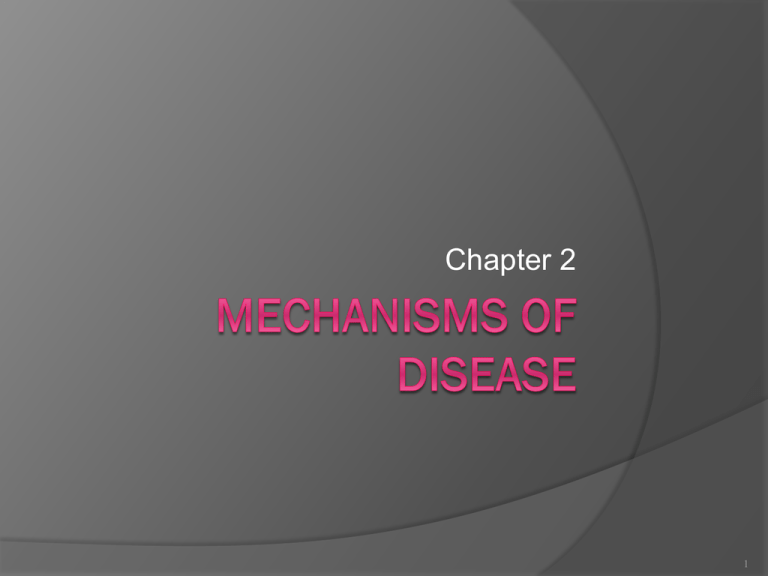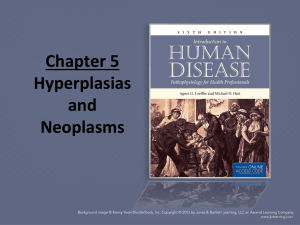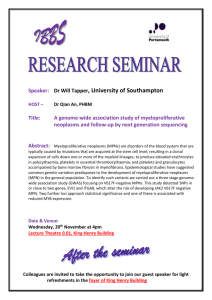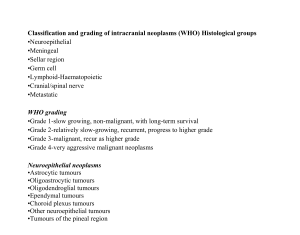Chapter 2 1
advertisement

Chapter 2 1 Causes of Disease Hereditary Trauma Inflammation/Infection Hyperplasias/Neoplasms Nutritional Imbalance Impaired Immunity 2 Hereditary Error in individual’s genetic or chromosomal makeup Congenital - disease present at birth Classifications of hereditary diseases Single gene abnormality Abnormality of several genes Abnormality of a chromosome 3 Trauma Caused by physical injury or external force Type of traumatic disease varies with: Age Race Residence 4 Trauma Classifications in order of prevalence: Motor vehicle accidents Falls Drowning Burns ingested or inhaled objects 5 Trauma Classification in order of prevalence: Poisoning Penetrating injuries Physical abuse 6 Inflammation/Infection Inflammation - protective immune response triggered by injury or irritant Infection - invasion of microorganisms into tissues causing cell or tissue injury 7 Hyperplasias/Neoplasms (continues) Hyperplasias - overgrowth in response to some type of stimulus Neoplasms - commonly called tumors Oncology - study of cancer 8 Hyperplasias/Neoplasms Neoplasms classified as: Benign - limited growth Encapsulated - enclosed in a capsule Malignant - uncontrollable growth 9 Hyperplasias/Neoplasms Cancer - malignant tumor Metastasize - moves and spreads Metastatic - moves from site of origin to secondary site in body 10 Nutritional Imbalance Most nutritional diseases are related to over or under consumption Cachexia - ill, thin, wasted appearance Alternatives: Parenteral - administered by injection Enteral - nutrition through small intestine 11 Impaired Immunity Body’s first line of defense is skin, mucous membranes, tears, and secretions Protective qualities of immune system: Leukocytes kill foreign invaders Body reacts to antigens by producing antibodies 12 Impaired Immunity Antigens - substances that cause harm and set off a specific response Antibodies - also called immune bodies Proteins that render the antigen harmless 13 Impaired Immunity Common ways immune system fails: Allergy Autoimmunity Immunodeficiency 14 Aging Degeneration Disease related to age Tissue degeneration changes functional activity to lower or lesser level Body’s ability to repair and replace itself slows down with aging process 15 Cellular Injury Causes of cellular injury and death: Hypoxia - not enough oxygen Anoxia - no oxygen Drug or bacterial toxins Viruses 16 Cellular Adaptation Types of adaptation: Atrophy - decrease in cell size Hypertrophy - increase in cell size Hyperplasia - increase in cell number Metaplasia - cell changes to another type 17 Cellular Adaptation Types of adaptation: Dysplasia - alteration in size, shape, and organization of cell Neoplasia - development of new type of cell with uncontrolled growth pattern 18 Cell and Tissue Death Necrosis - cellular death Ischemia - decreased blood flow Infarct - area of dead cells Gangrene - saprophytic bacteria involved in necrotic tissue 19 Organism Death Morbidity - state of being diseased Criteria for brain death: Lack of response to stimuli Loss of all reflexes Absence of respirations Lack of brain activity on EEG 20




